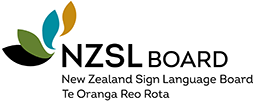Executive Summary
The New Zealand Sign Language Strategy 2018−2023 (the Strategy) addresses the critical and on-going need for effective language planning by the NZSL Board. Research tells us that while New Zealand Sign Language (NZSL) is now more recognised and accepted by society, the numbers of Deaf people learning and using the language are decreasing (McKee 2017). This means that NZSL – one of New Zealand’s official languages – is considered a threatened language.
The strategy aims to enable Deaf and other NZSL users to learn and use NZSL naturally within a community of users, contributing significantly to its survival, sustainability and vitality. Proposed promotional activities will help to increase recognition, awareness, learning and use of NZSL by all New Zealanders.
The Strategy will also guide the NZSL work happening in government agencies and crown entities to maintain and promote the use of NZSL by Deaf people and other NZSL users.
The Strategy is based on five internationally recognised language planning priorities:
- Acquisition: The learning of a language by children and adults.
- Use/Access: The ability to use a language in any or all domains of society, including within whānau.
- Attitude: The beliefs and opinions of language users and others towards that language.
- Documentation: The systematic recording of language use for research and reference.
- Status: How a language is regarded by its users and others.
For each of these priorities the NZSL Board has developed aspirational descriptions of what the future for NZSL will look like in 2023, after five years of strategic development. The descriptions enable a clear and shared understanding of what the Strategy and its associated activities are seeking to achieve.
The Board will develop an action plan of key activities to be progressed under each of the five strategic language planning priorities. The action plan will be reviewed and updated annually.
Many government agencies and Crown entities have a clear responsibility to provide NZSL services and resources and/or access to their services through NZSL, this will not change. The Board will work in partnership with key government agencies during 2018 to 2019 to jointly plan for the collation and analysis of more NZSL-related data. The aim is to develop targets and indicators that can start being reported against in 2020.
Page last updated:
